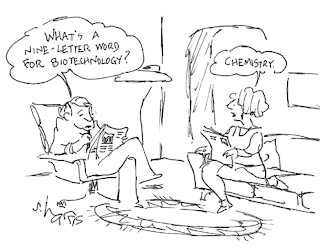Friday, June 25, 2010
Wednesday, June 16, 2010
Chemistry Humor
Two hydrogen atoms meet.
One says “I’ve lost my electron.”
The other says “Are you sure?”
The first replies “Yes, I’m positive.”
One says “I’ve lost my electron.”
The other says “Are you sure?”
The first replies “Yes, I’m positive.”
"How much for a beer?"
The bartender replies,
"For you, no charge."
. Heisenberg is out for a drive when he's stopped by a traffic cop.
The cop says: " Do you know how fast you were going?
Heisenberg replies: "No, but I know where I am".
Banana
What is the purpose of a doctor?
Helium.
Saturday, June 5, 2010
THE REACTION I LIKE MOST
Diels-Alder Reaction:
 The Diels-Alder reaction is essentially a cycloaddition reaction ( Cycloaddition reaction is one example of a special class of reactions called pericyclic reaction. Other examples of pericyclic reactions are electrocyclic reactions, sigmatropic reactions ) in which an alkene adds to a 1,3-diene to form a 6-membered ring. The reaction is synthetically very useful, due to the formation of cyclic product
The Diels-Alder reaction is essentially a cycloaddition reaction ( Cycloaddition reaction is one example of a special class of reactions called pericyclic reaction. Other examples of pericyclic reactions are electrocyclic reactions, sigmatropic reactions ) in which an alkene adds to a 1,3-diene to form a 6-membered ring. The reaction is synthetically very useful, due to the formation of cyclic productMECHANISM:
The Diels-Alder reaction mechanism still remains the topic of much debate because of the uncertainty as to whether the mechanism is stepwise, concerted, or free-radical. For the time being arrow-pushing concerted mechanism is preferred on order to better understand the beauty of this reaction.
Important Points to Remember:
Important Points to Remember:
1. The Diels-Alder reaction (a
4π+2π4π+2π size 12{"4π"+"2π"} {} cycloaddition) is a very important synthetic method for the preparation of cyclohexanes, mainly because the stereochemistries of the products are so well controlled.
2. Normal Diels-Alder reaction is favoured by electron withdrawing groups (EWG) on the electrophilic dienophile and by electron donating groups on the nucleophilic diene.
3. The diene must be cisoid (this refers to the conformation about the single bond). Example: trans-butene does not undergo DA reaction where cis-butene does.
4. The reaction is usually thermodynamically favored due to the conversion of
2 π−bonds2 π−bonds size 12{"2 π" - "bonds"} {}into 2 new stronger
σ−bondsσ−bonds size 12{σ - "bonds"} {}.
5. The Diels-Alder reaction is stereospecific with respect to both the diene and the dienophile.
6. Under the reaction conditions, the product can be broken down to its starting materials known as retro Diels-Alder reaction.
7. To predict the relative rates of reaction of dienes, use these rules.
(a) Only conjugated dienes react as dienes in Diels-Alder processes. Isolated and
cumulated dienes may react as dienophiles, but they cannot react as dienes.
(b) Dienes in the s-trans conformation do not react in Diels-Alder reactions. Acyclic
dienes may rotate around a single bond to become s-cis, but some dienes are locked in the
s-trans conformation in cyclic structures and cannot react.
(c) Dienes containing electron-releasing groups (usually alkyl groups) react faster,
especially with dienophiles that contain electron-withdrawing groups (almost always groups that contain electronegative atoms). The opposite combination also gives relatively fast reactions, but the starting materials are unusual.
Thursday, June 3, 2010
CAREER OPTIONS
The career options in chemistry are practically endless! However, your employment options depend on how far you have taken your education. A 2-year degree in chemistry won't get you very far. You could work in some labs washing glassware or assist at a school with lab preparation, but you wouldn't have much advancement potential and you could expect a high level of supervision. A college bachelor's degree in chemistry (B.A., B.S.) opens up more opportunities. A 4-year college degree can be used to gain admittance to advanced degree programs (e.g., graduate school, medical school, law school). With the bachelor's degree, you can get a bench job, which would allow you to run equipment and prepare chemicals. A bachelor's degree in chemistry or education (with a lot of chemistry) is necessary to teach at the K-12 level. A master's degree in chemistry, chemical engineering, or other field opens up far more options. A terminal degree, such as a Ph.D. or M.D., leaves the field wide open. In the United States you need at least 18 graduate credit hours to teach at the college level (preferably a Ph.D.). Most scientists who design and supervise their own research programs have terminal degrees. Chemistry is a part of biology and physics, plus, there are lots of categories of chemistry! Here's look at some of the career options related to chemistry:

Chemistry (chemist profile)
Ethnobotany
Environmental Law
Patent Law
Technical Writing
Pharmaceuticals
Oceanography
Software Design
Space Exploration
Government Policy
Forensic Science
Biotechnology
Metallurgy
Ceramics Industry
Plastics Industry
Paper Industry
Medicine
Teaching
Engineering (chemical engineer profile)
Geochemistry
Agrochemistry
Military Systems
This list isn't remotely complete. You can work chemistry into any industrial, educational, scientific, or governmental field. Chemistry is a very versatile science. Mastery of chemistry is associated with excellent analytical and mathematical skills. Students of chemistry are able to solve problems and think things through. These skills are useful for any job!
source:http://chemistry.about.com/cs/5/f/blcareers.htm

Chemistry (chemist profile)
Ethnobotany
Environmental Law
Patent Law
Technical Writing
Pharmaceuticals
Oceanography
Software Design
Space Exploration
Government Policy
Forensic Science
Biotechnology
Metallurgy
Ceramics Industry
Plastics Industry
Paper Industry
Medicine
Teaching
Engineering (chemical engineer profile)
Geochemistry
Agrochemistry
Military Systems
This list isn't remotely complete. You can work chemistry into any industrial, educational, scientific, or governmental field. Chemistry is a very versatile science. Mastery of chemistry is associated with excellent analytical and mathematical skills. Students of chemistry are able to solve problems and think things through. These skills are useful for any job!
source:http://chemistry.about.com/cs/5/f/blcareers.htm
Subscribe to:
Comments (Atom)






